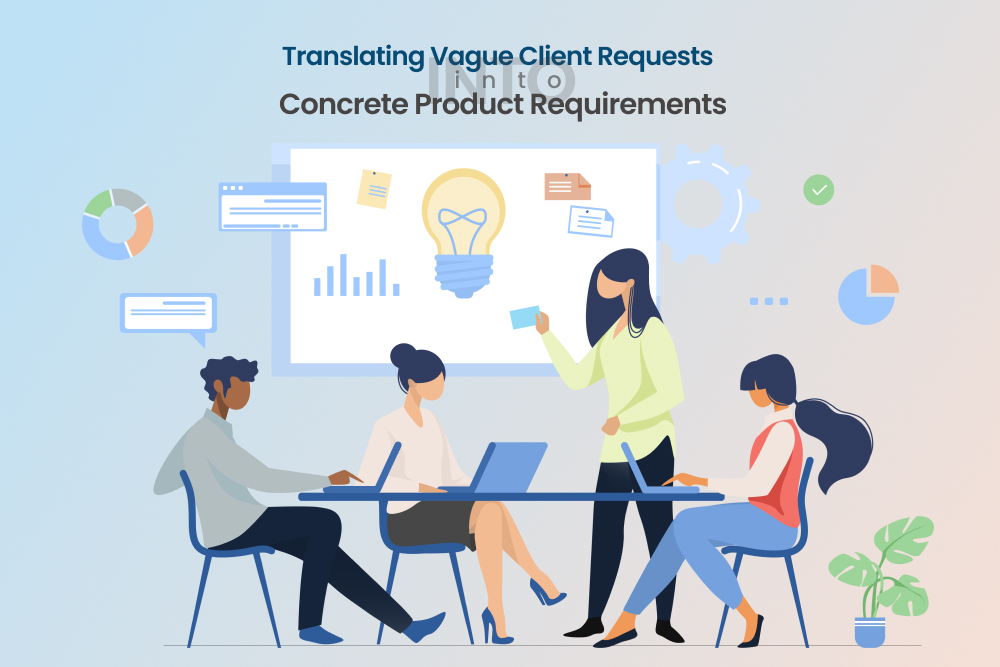Strategies for Translating Vague Client Requests into Concrete Product Requirements
The success of a product hinges on its development process, which begins with clear client specifications. When it comes to product development, the entire team must precisely define the application’s intended functionality. Unclear requirements pose a major challenge in managing a product, as dissatisfaction and unmet expectations can lead to increased production costs and deficient products. This often occurs due to a lack of understanding of the client’s needs from the outset. To tackle these challenges, this article outlines strategies for dealing with vague client requests and overcoming misunderstandings. By employing these tactics, teams can improve their ability to understand client needs and create a product that meets their expectations.

Overcoming challenges in capturing product requirements
Capturing product requirements can be a challenging task, especially when it comes to interpreting a client’s needs and translating their “voice” into clear user requirements. One effective approach is to conduct an initial interview with the client, seeking their problems and proposed solutions. Scheduling an informal and candid conversation can help in gathering their initial thoughts and ideas. However, there are several challenges to keep in mind during the early stages of product scoping. It is essential to identify and manage the following red flags to prevent any potential derailment in product development:
- A lack of technical literacy in the client can result in vague and unfeasible requirements that do not align with their expectations. In order to bridge the gap between technical and non-technical clientele, precise communication is essential.
- Poor or infrequent communication between the product manager and the client can lead to misunderstandings and unsuccessful outcomes.
- Regular and transparent communication is vital to ensure both parties are on the same page.
- A client may not have fully thought through the project, leading to unattainable goals and unrealistic requirements. It is the product manager’s responsibility to differentiate between the necessary and nice-to-have features to establish achievable goals.
- Over-ambitious product ideas that are beyond the budget or technology capabilities can pose significant challenges. It is essential to address and establish realistic goals early on in the development cycle.
- High-pressure deadlines can result in rushed scoping and disagreements over project scope, leading to relationship issues and poor development outcomes. Conducting due diligence is necessary to define a well-defined and realistic project scope.
- Constantly changing feature sets can lead to incomplete requirements, increased costs, and poor product quality. It is crucial to consider the interrelationships between features and maintain a holistic view of the product to account for any changes.
Why capturing specifications is crucial for product development success?
Capturing specifications is a critical aspect that significantly impacts the end result and overall quality of a product after its development process. The product’s specification is the foundation of the entire digital product, and it plays a pivotal role in its success.
The software specification process typically begins with creating user stories, and it is crucial to distinguish between good and bad ones. Poorly written user stories can lead to undesirable outcomes since they fail to accurately describe the desired behavior of the application. Therefore, it is crucial to recognize the difference between effective and ineffective user stories in order to ensure a desirable end result. Indicators of poorly written user stories include:
- Written from a product owner or client’s perspective
- Written from a developer’s perspective
- Too big or contains too many steps
- Lacks value to customers or end-users
- Highly dependent on other user stories
- Does not provide enough information
Best practices for helping clients specify product requirements
When starting a product development process, it’s crucial to have a clear set of product requirements. However, clients come from diverse backgrounds, and they may need assistance to accurately define their product requirements. Here are some best practices to help you capture their product requirements:
Ask for examples: Start by asking the client to share features from other apps that are similar to what they want in their own app.
Create detailed mockups: Ask the client for mockups or drawings of what they want in a feature. Create a detailed outline of how it can be implemented, and share it with the client for feedback.
Use a Product Requirements Document (PRD): Create a detailed PRD that contains every explicit feature required for the product’s release. The document should also include an accompanying use case that illustrates how an end-user will utilize the functionality and a plan to test it. Additionally, specify which end-user environments are supported, such as mobile operating systems, processing power, memory, and web browsers.
Be precise with user stories: Ensure that user stories are precise and specific to the features that will be used to implement them. Specify which features will be left out if a feature is built in a particular way.
Understand the “why” behind a feature: Ask the client why they want a specific feature and understand the end goal behind it. This helps zero in on a specific set of features in a simpler way.
List out end-user expectations: List out what is expected of end-users and specify any limits or third-party elements required for the product to function.
Summary
In conclusion, poorly defined requirements can result in project delays, failures, and wasted resources such as time, effort, and money. Unclear product specifications can also lead to missed deadlines and suboptimal software development. At Centizen, we offer managed app development services led by experienced product managers. We place great emphasis on creating highly detailed PRDs prior to starting development, and we have a proven track record of assisting non-technical clients in capturing their exact product requirements.
Centizen
A Leading IT Staffing, Custom Software and SaaS Product Development company founded in 2003. We offer a wide range of scalable, innovative IT Staffing and Software Development Solutions.
Contact Us
USA: +1 (971) 420-1700
Canada: +1 (971) 420-1700
India: +91 63807-80156
Email: contact@centizen.com
Our Services
Products
Contact Us
USA: +1 (971) 420-1700
Canada: +1 (971) 420-1700
India: +91 63807-80156
Email: contact@centizen.com






